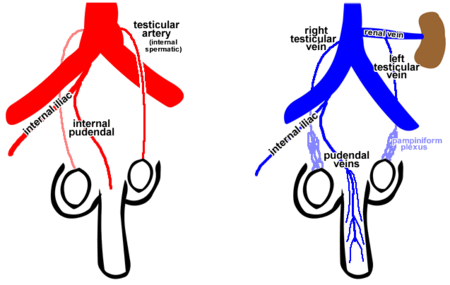Testis
Structure and Function
These are the male reproductive organs. They are covered with several layers of fascia. The first is the tunica albuginea, a tough fibrous capsule that covers the testes. The rest are derived from the testes passage from around T11 down to the scrotum.
As they pass through the layers of peritoneum or abdominal muscle, they attain extra layers of fascia. The tunica vaginalis is derived from the processus vaginalis – an embryological thing. Sometimes, abnormalities in this lead to formation of a hydrocele – fluid trapped in front of the testes, or sometimes even an inguinal hernia – where the part of the intestines slips down into the scrotum.
Testes can only produce sperm at around 3°C less than body temperature, so the scrotum allows this – and the muscles in that are somehow involved (no one really understands quite how). The pampiform plexus is a network of vessels surrounding the spermatic cord which allows blood to cool down on its way through the testicular artery/veins.
Sex Cells
Each testes contains about 1000 seminiferous tubules, containing germinal epithelium. This epithelium contains Sertoli cells (phagocytic support and sperm production) and Leydig cells (testosterone production that promotes spermatogenesis). These tubules drain into ducts that transport the newly produced spermatozoa to the epididymis.
- Leydig cells – produce testosterone
- Sertoli cells – sperm production happens inside these, ending up in a lumen behind them. The sertoli cells have tight junctions, forming the blood testes barrier, which keeps spermatozoa in a safe environment. They also produce inhibin.
Clinical Conditions
Hydrocele
Commonest intrascrotal swelling. Rarely harmful, but can be an obstruction. Two causes:
Congenital
Babies are born with it. Tunica vaginalis mishapes can lead to a connection between the abdominal cavity and the testes, leading to an accumulation of fluid in the ball.
Acquired
People develop it later. Tends to be associated with other pathologies, such as tumour or infection. Once again, if a swelling appears suddenly, probably worth checking out.
Orchitis
Literal meaning is inflammation of the testis Two main causes:
UTIs
Linked to epididymo-orchitis. Most commonly happens in a coliform (organisms from the bum) infection. The testes and epidymis are enlarged, warm and painful. These signs are accompanied by fever and malaise. Usually the inflammation is mild, and can get sorted out with a bit of antibiotics. This can accompany a septicaemia – such as meningococcal.
Mumps
Seen mostly in younger children. Painful testicular enlargement, usually unilateral. Increasing pressure leads to blood vessel ichaemia and necrosis of seminiferous tubules. In many cases the inflammation leads to fibrosis, and reduced fertilitiy.
Also sometimes seen in glandular fever.
Epididymo-orchitis
See epididymis.
Testicular Cancer
Generally presents with:
- Painless unilateral enlargement of testis
- Secondary hydrocele
- Symptoms from metastases (lungs, bones)
- Retroperitoneal mass
- Gynaecomastia (breast tissue growth)
Usually there is a slow painless growth on one testicle, that is hard and often irregular. Ball cancer is the biggest malignant killer in males under 35, and it comes in two different flavours:
Teratoma
Very aggressive. The more well differentiated the tumour is, the better the prognosis. However, since it is so aggressive, it does respond very well to chemo.
Seminoma
Commonest type of testicular cancer. Less aggressive, and peaks in 30-50 year olds. Again, the more well differentiated, the better the life expectancy. If picked up late, bad prognosis, because its less responsive to chemo.
